I decided to write this post to elaborate on cultural and philosophical aspects of erotic sculptures found at Khajuraho. Reading about the origins of artistic expressions of erotica in India, made me want to write this little post about the origin and consequences.
Highlights of Erotica in Khajuraho:
The erotica of Khajuraho can be broadly classified into four groups.
- Maithuna (Love Scenes)
- Maithuna (Coitus)
- Erotic Group
- Bestiality
Most of the coitus scenes are marked with explicit depiction of men shown making medicine, probably Bajikarana, an ayurvedic (herbal) medicine for sexual potency. The erotic groups often depict noble men and women in pre-coital position often aided by attendants, perhaps a Tantrik religious ritual. Homosexuality and Bestiality although scarce is found on the outer walls of the temples.
Walking around the temples of Khajuraho , one would find random placement of erotic sculptures on the outer walls of the temples or at the pillars and doorways. However the placement of sculptures is not random. They are placed as per the prescriptions of Shilpashastras which postulated that the juxtaposition of the erotic sculptures against the haloed and sacred precincts of a temple is a good omen and brings good luck to the builders. Generally it is believed, and, sometimes manifest also in real life, that a prosperous society tends to harbour a more liberated stand towards sex with lesser inhibitions and a healthier viewpoint.
Once can attribute the rich artistic explosion at Khajuraho to the openness and prosperity in the society at that time. The decline in quality of art towards the end of 12th century perhaps points to the changing times with various invasions.
Notes on Origin of Artistic Erotic Expressions in India:
The earliest form of artistic expressions on erotica is in the form of cave paintings. Coitus is often depicted as a religious ritual for progeny. Various sexual acts sometimes performed in front of the village headman can also be seen. Evidence of Homosexuality can be found in many Chalcolithic cave paintings. The first major form of erotic expression can be dated back to the Harappan Civilization (Pre – Vedic) where numerous evidence of Phallus worship is found.
The earliest forms of Shivalingas are found around the region of Sanchi which is close to Khajuraho. Many early temples especially those found in Aihole, Patadakal have depictions of erotica. This was not just found in Vedic or Pre-Vedic religions but also in contemporary sects of Jainism and Buddhism. The 9th century saw the boldest expression of erotica in the form of Khajuraho.
The 20th century writers advocated the association of temples with the Kaula-Kapalika cults, then prevailing at Khajuraho. The erotica of Khajuraho was the result of hedonistic activities of the Tantrika sects. However it is common knowledge that erotic sculptures are found all over the country in varying degree dateable from 900 A.D to 1400 A.D.
Social & Religious Orders at Khajuraho during the 8th Century:
What is remarkable from the standpoint of religious order is the presence of some kind of fusion and synthesis of Brahmanical and Tantrika pantheons, at Khajuraho. Around the 8th century A.D, Brahamana dharma had started bringing, in its fold, the tenets of Tantra, namely, mantra, yantra, mandala, nayasa etc. The period following the 9th century A.D is marked with bold expression of erotica. The temples were constructed by royal Kings and Chiefs, under the guidance of Vedic Brahmins. The artist was given free rein to his imagination, which in turn reflected the then prevailing social norms, economic conditions and, thereby, seen as mirroring the contemporary society in its entirety. The erotic sculptures not only represent the entire life process- philosophy in which the sex energy (kama) changes into cosmic energy (God) but comprised an essential part of the ornamentation of the temples.
Philosophy behind the Erotica:
Hinduism envisages four aspects of life (Purusarthas), i.e Dharma (Religion), Artha (Wealth), Kama (Sex) and Moksha (Salvation). Kama is the point of focus to understand the philosophy behind erotica in temples. Kama is described as kind of Yogic phenomenon (Swadhyaya) where one experiences utter freedom and liberation. Sex is a form of liberation of pent up feelings. The feeling is believed to originate from the sex-centres (Muladhara) (Folks, I am not talking about brothels 🙂 ) and tends to expand outwards, but as one goes deeper and deeper into meditation the same energy moves upwards to merge with its own base (Paramsiva).
The Unnatural erotic behaviour as depicted in various sculptures is exactly proportionate to the intensity of the suppressed feelings of any given people. Suppressed feelings are expressed in other forms such as anger and violence. Thus, sex enables man to become lighter and wiser and be able to focus one’s energy to reach the Gods. This explains the reason why the number of erotic sculptures become lesser and lesser as one proceeds from the outside to the inside of the temple and is completely absent in the Sanctum. However, there have been corner cases where erotic sculptures were found inside the Sanctum. The possible explanation could point to the fact that as man tries to achieve Moksha by mere suppression of feelings rather than true realization would not fail at the doorway to God. This probably explains the rare erotic sculptures inside the sanctum to point out the remaining shreds of Kama which prevents a man from attaining Moksha. Liberation from Kama can only be achieved by Yoga and Meditation.
Two paths to achieving Moksha were practiced by various sects during the medieval times in India. Moksha can be achieved only by defeating Kama which can be accomplished through meditation. Various sages including Mahavira, Buddha promoted this path to Moksha however was not followed by majority of the masses. The second path to defeat Kama was derived from Tantric philosophy. In this regard, Tantra recognises three important components. Bhogi, or one who indulges in sexual pleasure, without understanding the same. Yogi, or the one who suppresses one’s feeling, as a matter of deliberate negation. Tantrika, or one who encompasses characteristics of bhogi and yogi. A Tantrika does not deliberately restrain his passionate feelings and desires, but knows them and lives through them, as a way of going beyond them. A Tantrika lives like a bhogi, albeit with a difference. He does not indulge in unrestrained, mindless pleasure activities, nor does he suppress his desire, as a yogi. Hence a confluence of the situation of a bhogi and the mind of a yogi is imperative for achieving the ultimate bliss. This is the very ideology, in its entirety that the Khajuraho temple depicts.
Conclusions:
Khajuraho attracted pilgrims from far and wide, a site that surprised and shocked the uninitiated visitor. Yet the message was always loud and clear. If you are lost in the labyrinth of the world, how will you enter the garbagriha of truth?

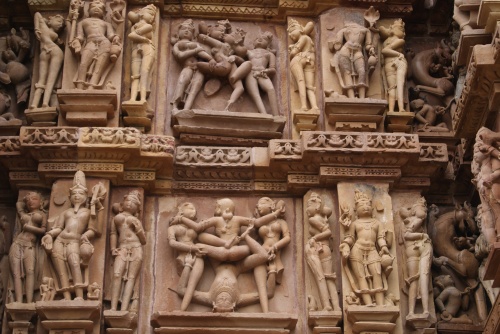

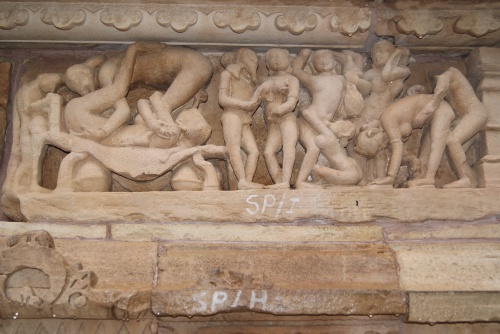





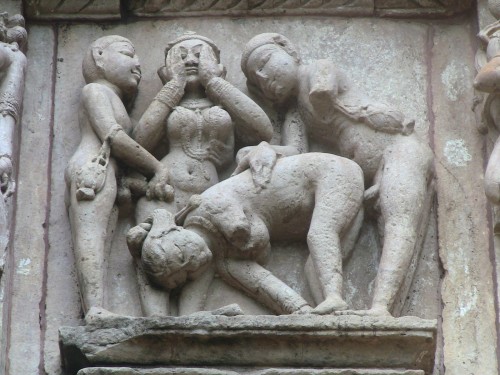
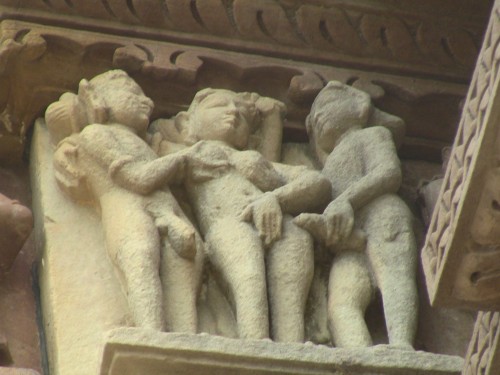
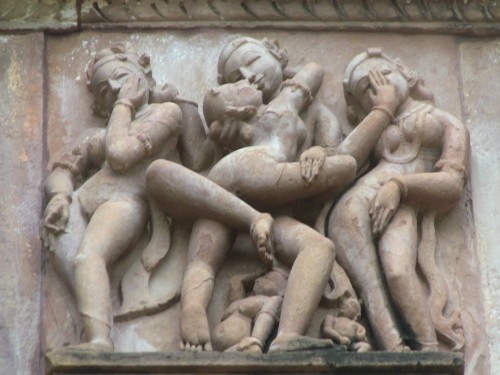





Pingback: Khajuraho – Romance In The Jungle, MP, India | Hobbies Of The Earth Bound Misfit
Interesting read! I had seen these images before…
I liked it – situation of a Bhogi and mind of a Yogi. Is that not true detachment. Live like a fish but don’t get wet.
We read about Khajurao back in school days, but I dont think we ever studied this aspect of the temple architeture !!
only in Khajurao ? quite different with Borobudur’s Karmawibhangga
Awesome writeup
GOOD article , in fact this is what should be told about Khajuraho and not Kama Sutra !!
Well researched and informative! I had visited Khajuraho last year and developed my own theories as to how and why these erotic sculptures came to be…If you’re interested in a more humorous take on the topic: